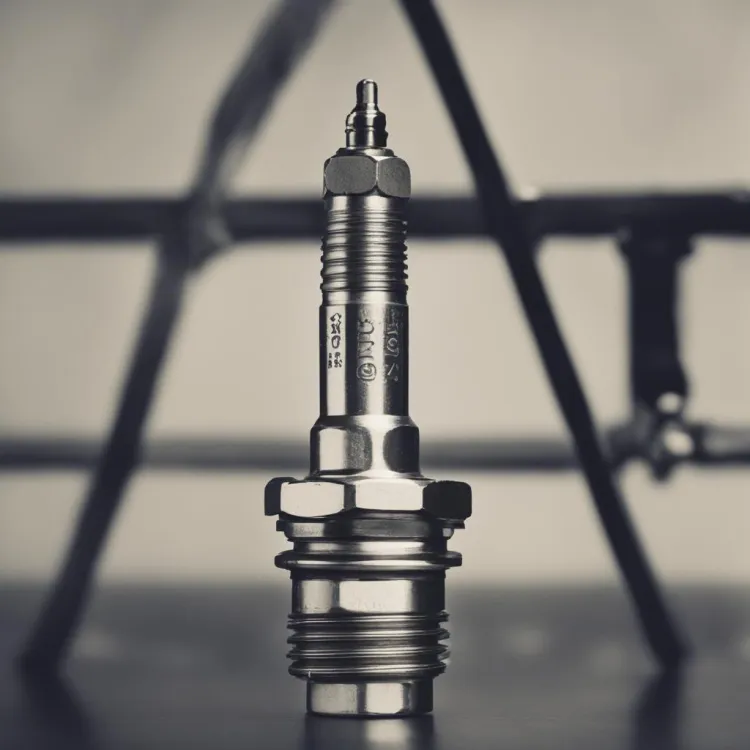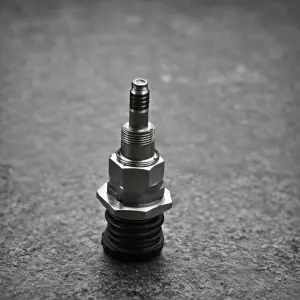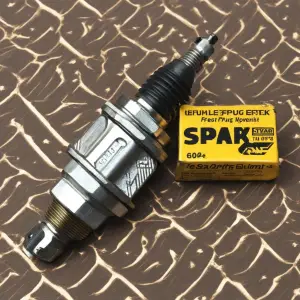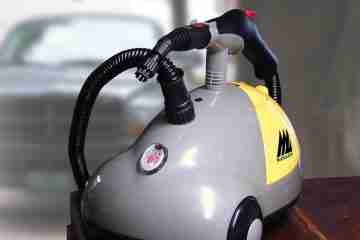Spark Plugs 101: Your Go-to Guide

What Is a Spark Plug?
So what exactly is a spark plug? Basically, it’s a device that provides the spark needed to ignite the air-fuel mixture in an internal combustion engine.
How Spark Plugs Work
A spark plug consists of an insulated metal thread (-) called an electrode (-) that extends into the engine cylinder. At the tip of the electrode is a spark gap (-) where the spark occurs. The electrode is connected to the ignition coil, which provides the high voltage needed to create the spark.
When your engine is running, here’s what happens:
- Air and fuel enter the cylinder
- The piston moves up and compresses the air-fuel mixture
- At the top of the compression stroke, the ignition coil sends voltage to the spark plug
- The voltage travels down the electrode and jumps the gap, igniting the compressed air-fuel mixture
- The spark ignites the mixture, forcing the piston down, which powers the engine
Without functioning spark plugs, your engine wouldn’t run. Spark plugs ignite the combustion process in your engine that provides the power to turn the crankshaft and ultimately propel your vehicle.
Replacing Your Spark Plugs
Over time, spark plugs become worn and dirty, making the spark gap wider and less effective. Replacing your spark plugs according to your vehicle’s recommendation – typically every 30,000 to 60,000 miles – can help maximize performance and fuel economy. When it’s time for replacement, just remove the old plugs, gap and install the new ones, and you’ll be back on the road in no time with a smooth-running engine.
So in summary, spark plugs are a crucial engine component that continually provide the sparks of ignition to keep your vehicle running. With basic maintenance, they’ll serve you well for miles to come!
The Anatomy of a Spark Plug
A spark plug is one of the most important parts of your vehicle’s ignition system. It’s what actually ignites the air/fuel mixture in the combustion chamber of your engine. Let’s break down the anatomy of a spark plug:
The Insulator
The insulator is the ceramic center section of the plug. It surrounds the central electrode and insulates it from the metal casing. The insulator needs to withstand very high temperatures, up to 4,000°F, so it’s made of aluminum oxide ceramic.
The Central Electrode
The central electrode is the rod that extends from the bottom of the insulator into the combustion chamber. It’s made of materials that can conduct the electric current from the ignition system, such as copper, platinum or iridium. The central electrode also needs to withstand extremely high heat without corroding or deteriorating.
The Ground Electrode
The ground electrode is the bent arm that extends parallel to and near the central electrode. It provides the path for the electric current to arc across, igniting the air/fuel mixture. The gap between the two electrodes is carefully controlled and calibrated for your specific engine.
The Metal Casing
The metal casing, typically made of steel, surrounds and protects all the inner components. It has threads that allow it to be screwed into your engine’s cylinder head. The casing also helps transfer heat away from the insulator and electrodes.
The Seal and Gasket
A spark plug has seals and gaskets to contain the high-pressure gasses inside the combustion chamber. The main seal is a ring that fits over the insulator and under the metal casing. Additional seals and gaskets installed by the vehicle manufacturer seal the plug to the engine block.
Keeping your spark plugs in good working condition with regular replacement and maintenance is key to optimal engine performance, fuel efficiency and reduced emissions. Now you know what’s really sparking under the hood!
How Does a Spark Plug Work?
A spark plug is a device that delivers electric current from an ignition system to the combustion chamber of an internal combustion engine. The spark plug ignites the fuel and air mixture with a spark, which powers the engine.
How It Works
The spark plug sits at the top of the engine’s cylinder head and has exposed electrodes made of conductive metal. When the ignition system sends current to the spark plug, it arcs across the gap between the electrodes, igniting the compressed fuel and air mix in the cylinder.
The firing of the spark plug is timed to coincide precisely with the piston reaching the top of its compression stroke. The spark causes the fuel and air mix to burn rapidly, which creates an explosion that drives the piston downwards, powering the engine. The waste gasses then exit the cylinder through the exhaust valve.
The spark plug has to fire at exactly the right moment and produce a strong enough spark to ignite the fuel-air mixture. If it fires too early or too late, power and efficiency will drop. The spark also has to be hot enough, around 3,000°C, to ensure the mixture ignites properly.
The key to an efficient spark is the gap between the central and side electrodes. This has to be perfectly calibrated – too small a gap won’t produce a spark, while too large a gap will require a higher voltage to jump the gap, reducing efficiency.
Over time, the electrodes can wear out or become coated in deposits, making the spark plug less effective. Most vehicle manufacturers recommend replacing spark plugs between 20,000 to 40,000 miles to keep your engine running at peak performance. Replacing worn-out or fouled spark plugs can improve your gas mileage by up to 30% and reduce pollution.
So in a nutshell, that’s how a spark plug works – by producing a high-voltage spark at precisely the right moment to ignite the fuel and power your engine. Simple but ingenious!
The Importance of Properly Gapped Spark Plugs
The spark plugs in your vehicle’s engine are responsible for igniting the air/fuel mixture in the combustion chambers. For your engine to run properly, the spark plugs must fire at just the right time. If the spark plugs are not gapped correctly, it can lead to misfires, loss of power, rough idling, and poor fuel economy.
The Importance of Properly Gapped Spark Plugs
The gap between the center and side electrodes of a spark plug determines the intensity of the spark. The spark must be large enough to reliably ignite the air/fuel mixture. If the gap is too small, the spark may not be sufficient. If the gap is too large, the spark may fire at the wrong time or not at all.
Most spark plug manufacturers will provide a gap specification for their plugs that will work well for a wide range of engines. However, for best performance, you should gap your plugs to your vehicle’s recommended specification listed in the owner’s manual or service manual. The gap is measured in thousandths of an inch, so you’ll need a spark plug gap tool, which is a specialized set of feeler gages.
To properly gap a spark plug, you carefully adjust the side electrode by bending it. Make small adjustments and frequently check the gap with the feeler gage. It’s best to gap new plugs before installation. For used plugs, clean them first with a wire brush to remove any built-up deposits before gapping and reinstalling them.
Properly gapping your spark plugs is a simple procedure that can have significant effects on your vehicle’s performance and efficiency. By taking the time to gap your plugs to the recommended specification, you’ll enjoy smoother running, better acceleration, optimized fuel economy, and fewer misfires. For the minimal investment of time, properly gapped spark plugs yield substantial returns in vehicle operation and dependability.
Common Spark Plug Issues and Failure Modes
Spark plugs don’t last forever. Over time, the electrodes can wear out or become damaged, affecting your engine’s performance. It’s a good idea to inspect your spark plugs regularly and replace them when needed. Here are some common signs that your spark plugs may need replacement:
Fouling
If your spark plugs become coated in carbon deposits, it can prevent them from firing properly. This is known as “fouling” and it reduces engine power and acceleration. Fouled spark plugs need to be cleaned or replaced.
Electrode Gap
The gap between the center and side electrodes needs to be properly set for your engine. If the gap is too wide, the spark may not fire. If it’s too narrow, the electrodes can overheat. Check your owner’s manual for the correct gap and adjust or replace spark plugs as needed.
Melting or Damage
Severely damaged or melted spark plugs will not fire and need replacement. This type of damage is usually caused by overheating, incorrect spark plug type (too hot of a heat range), or an underlying engine issue. It’s best to replace all spark plugs and investigate the root cause of the problem.
Oil Fouling
If there is oil on your spark plugs, that indicates an issue with valve guides, piston rings, or other parts of the engine. The oil is leaking into the combustion chamber, coating the spark plugs and preventing them from firing properly. New spark plugs may provide a temporary fix but the underlying oil leak needs to be addressed to prevent fouling the new plugs.
Age and Mileage
As a general rule, spark plugs need to be replaced every 30,000 to 120,000 miles depending on the type of plug and vehicle. Even if the spark plugs appear to be working fine, the electrodes and insulators will slowly deteriorate over time and with use, making replacement necessary for peak performance. When in doubt, new spark plugs can improve starting, acceleration, fuel economy, and emissions.
How to Inspect Your Spark Plugs
To keep your vehicle running well, it’s important to inspect your spark plugs regularly. Spark plugs ignite the fuel and air mixture in the engine, and over time they can become dirty or worn out, negatively impacting performance.
Check the condition
Pop the hood and locate the spark plugs—they’ll be the ceramic insulators sticking out of the top of the engine. Each spark plug should have an insulator that is light brown or gray in color. If one looks very dark, that cylinder isn’t firing properly. That spark plug will need to be replaced.
You should also check that the spark plugs are securely fastened in place. Spark plugs that are loose can prevent the engine from starting or running well. Tighten any loose spark plugs with a spark plug socket and ratchet.
Measure the gap
The gap between the center and side electrodes of the spark plug must be properly set for the engine to run efficiently. Use a spark plug gap tool to measure the gap on each spark plug. The correct gap specification can be found in your vehicle’s service manual. If the gap is too large or too small on any plug, you’ll need to adjust it.
Consider replacement
As a rule of thumb, most spark plugs need to be replaced every 30,000 to 90,000 miles depending on the material. Platinum and iridium plugs tend to last the longest. If your spark plugs are fouled or the gaps can’t be adjusted properly, it’s best to replace them.
Replacing your spark plugs yourself can save you money versus having a shop do it. Make sure to get the correct spark plug type for your specific vehicle make and model. Cleaning and adjusting your spark plugs regularly, or replacing them if needed, will help maximize performance, increase fuel efficiency and reduce harmful emissions. Your engine and your wallet will thank you!
When to Change Your Spark Pl
ugs
When should you change your spark plugs? As a general rule of thumb, you should replace your spark plugs every 30,000 to 60,000 miles depending on your vehicle make and model. However, there are a few signs that it may be time for a replacement:
Difficulty Starting
If your engine is struggling or cranking longer to start, it could indicate that your spark plugs are worn out or fouled, interfering with the ignition system. Faulty spark plugs have trouble producing the strong spark needed to ignite the fuel-air mixture in the cylinders.
Rough Idling
Pay attention if your vehicle seems to shake, vibrate or rumble when stopped at a light. This could point to spark plugs that need to be replaced, as they are having trouble consistently igniting the fuel to keep the engine running smoothly.
Loss of Power
Feeling like your vehicle has lost some of its pep or responsiveness? Weak or malfunctioning spark plugs often have trouble burning all of the fuel in the cylinders, resulting in a loss of power, acceleration and engine performance.
Increased Fuel Consumption
If your gas mileage has significantly dropped, it could indicate your spark plugs need to be replaced. Faulty or worn out spark plugs can’t burn the air-fuel mixture efficiently, so more fuel is required to power your vehicle. New spark plugs can help restore your gas mileage back to normal.
Misfires or Stalling
A misfire occurs when a spark plug fails to ignite the fuel in a cylinder. You may feel a jerking sensation while driving. If left unaddressed, misfires can lead to stalling, as the engine struggles to run properly. It’s best to have your vehicle checked by a mechanic as soon as possible. They can test your ignition and spark plugs to determine if replacement is needed.
Regular replacement of your spark plugs according to the vehicle manufacturer’s recommendations is the best way to avoid performance issues and keep your engine running strong. When in doubt, it never hurts to have them tested—it could save you money and frustration down the road.
Choosing the Right Spark Plugs for Your Vehicle
Choosing the right spark plugs for your vehicle is important to keep it running efficiently. The wrong spark plug can reduce performance or engine damage over time.
Heat Range
The heat range indicates how hot the spark plug will get during operation. A hotter plug is better for high-performance engines, while a colder plug is better for normal driving. Check your owner’s manual for the recommended heat range for your vehicle make and model. Using the wrong heat range can lead to pre-ignition, fouling, or other issues.
Gap Size
The gap size refers to the space between the center and side electrodes of the spark plug. The proper gap size is specified by the vehicle manufacturer. If the gap is too small, the spark may be too weak. If the gap is too large, the spark may misfire. Using a spark plug with the wrong gap size can reduce performance, increase emissions, and cause damage.
Material
Most spark plugs have a center electrode made of copper, platinum, iridium or other materials. Platinum and iridium provide a stronger spark and last longer. For most vehicles, copper or platinum plugs work well for normal driving. Iridium plugs are best for high-performance or long-life applications. Check which material is recommended for your vehicle to determine the best choice.
Brand
Stick with a reputable brand for spark plugs, such as AC Delco, Autolite, Bosch, Champion, Denso or NGK. Lesser-known brands may not meet the specifications for your vehicle or provide the same quality and performance. For the best results, choose a brand recommended in your owner’s manual or by other owners of your vehicle make and model.
By choosing spark plugs with the proper heat range, gap size, electrode material and from a trusted brand, you’ll help keep your engine running strong for the long haul. Be sure to reference your vehicle’s recommendations to get the right parts for your specific make and model.
Spark Plug FAQs: Your Top Questions Answered
Spark plugs are a critical component of your vehicle’s ignition system, but they can seem complicated if you’re not familiar with them. Here are the answers to some of the most common questions about spark plugs.
What exactly is a spark plug?
A spark plug is a device that fits into your engine’s cylinder head and ignites the air/fuel mixture in the cylinders. It contains an insulated electrode that provides the spark to ignite the gasses. The spark plug’s metal casing is also grounded to the engine to complete the circuit.
How often should I replace my spark plugs?
As a general rule of thumb, you should replace your spark plugs every 30,000 to 60,000 miles depending on the make and model of your vehicle. The exact recommendation can be found in your owner’s manual. Old or worn out plugs can reduce performance and fuel economy.
What happens if I don’t replace my spark plugs?
Neglecting to replace your spark plugs as recommended can lead to loss of power, misfires, hard starts, and reduced acceleration. In severe cases, it may cause permanent damage to your engine or catalytic converter. It’s not worth the risk to avoid this simple maintenance.
What are the different types of spark plugs?
The most common types are copper, platinum, and iridium. Copper plugs are cheap but need frequent replacement. Platinum and iridium plugs last much longer but are more expensive. Double platinum and fine wire iridium plugs tend to give the best performance for most vehicles. Check your owner’s manual for the recommended type for your specific vehicle make and model.
How much do spark plugs cost to replace?
The cost to replace your spark plugs can range from $50 to $300 or more, depending on the type of plugs needed and whether you do it yourself or have a shop replace them. High-performance iridium plugs and plugs for exotic vehicles tend to cost significantly more. Replacing the plugs yourself can save you a lot of money versus paying a mechanic.
Hope this FAQ helps demystify spark plugs and gives you the information you need to keep your engine firing on all cylinders. Let me know if you have any other questions!
Conclusion
So there you have it, a quick guide to spark plugs and how they work to power your vehicle. Now you know why your spark plugs are so important, how they function, the signs that mean it’s time for replacement, and how to properly gap new ones for installation. Pretty impressive that such a small part can have such a big impact. Next time your check engine light comes on or your ride is running rough, you’ll be equipped with the knowledge to diagnose if your spark plugs could be the culprit. And when it’s time for a tune-up, you’ll be ready to handle spark plug replacement yourself to save money and feel the increased power as your engine ignites. Stay tuned for more bite-sized tutorials to become an automotive expert in your own garage.
















No Comment